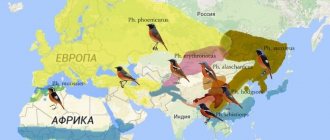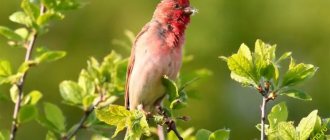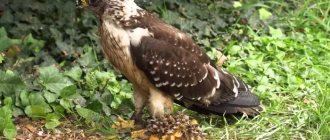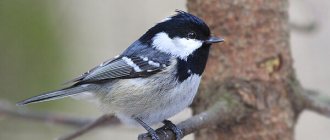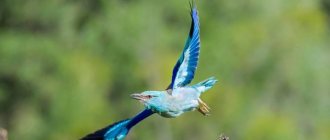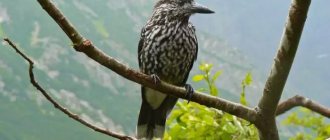- Wild animals
- >>
- Birds
The kiwi bird is very curious: it cannot fly, it has loose, hair-like feathers, strong legs and no tail. The bird has many strange and wonderful features that have evolved from New Zealand's isolation and lack of mammals. It is believed that kiwi have evolved to occupy habitats and lifestyles that would not be possible in other parts of the world due to the presence of mammalian predators.
What does it look like
— Advertising —
Kiwi bird looking at the camera
Kiwi has an unusual body structure for a bird. The body is pear-shaped, the head is small, and the neck is short. The eyes are round and small - their diameter is only 8 millimeters. Large auditory canals are located in the lateral walls of the skull. The kiwi's beak is long, thin, flexible, and slightly curved at the end. The length of the beak reaches 10-12 centimeters. The nostrils, unlike other bird species, are located at the end of the beak. Kiwis don't have a language. At the base of the beak there are many small bristles - vibrissae (the same as the whiskers of a cat or dog), which serve as an organ of touch. Kiwis have well-developed hearing and sense of smell, but birds have poor vision. The kiwi has no tail. The legs are short, thick, four-toed with sharp long claws. With the help of powerful paws, birds dig long underground labyrinths.
kiwi bird underground
Kiwis are flightless birds . Many people believe that these birds do not fly because they do not have wings, but this is not true. Kiwi birds still have wings, but they are not developed, tightly pressed to the body, their size is 4-5 cm. Under the thick feather layer, the wings are practically invisible.
— Advertising —
Kiwi bird sitting on the ground photo
Kiwi has plumage atypical for birds. Feathers are more similar in structure to wool - they are small, short and hard. The color is gray-brown with white and black strokes around the perimeter of the body. Kiwis moult several times a year. At this time, birds completely change their plumage. Kiwi feathers emit a specific smell, similar to a mushroom one. This feature makes birds vulnerable to predators, who can easily find their prey by smell.
Why kiwi is a bird
Why is a kiwi bird, photo of a kiwi bird close up? The habits
and lifestyle of a kiwi indicate that these birds belong to mammals: these birds cannot fly, live in the ground, run fast, hunt using their sense of smell, and the female kiwi has two functioning ovaries at once. Despite this, scientists still classified these unusual creatures as birds because they have a beak, wings (albeit undeveloped), long clawed four-fingered paws and plumage.
Construction of holes
Kiwis are burrow-dwelling birds. Birds do not have a single principle for digging houses. There are burrows several meters long with 2-3 exits. Large gray kiwis prefer such dwellings. Ordinary minks with one entrance are also common.
Birds do not limit themselves to one hole, but prudently dig out several dwellings at once. They wait several weeks for moss and tall grass to grow around the house. The birds themselves also camouflage their burrows with large leaves.
Kiwis hide in them all day, so they don't overheat under the scorching New Zealand sun.
Where does the Kiwi bird live?
Kiwi walks on the grass
The kiwi bird lives in New Zealand. Bird families live on almost all the islands of the New Zealand chain. The largest number of birds constantly nest on one of the two main Zealand islands - North Island. The South Island is home to the Common Kiwi, Great Gray and Rovi. Capita Island is inhabited by the Lesser Gray Kiwi. The habitat of the kiwi bird is the territory of New Zealand.
Habitats
Where does the kiwi bird live photo
Kiwi birds live in secluded places, far from the habitats of other animals and birds. For their residence, they choose moist evergreen forests and swampy areas. Initially, the birds lived only in the subtropics, however, human economic activity and predatory animals brought to the islands by people and hunting kiwi forced the birds to move to the mountains, savannas, subalpine meadows and shrub groves. Birds hide in tree hollows or burrows among dense vegetation.
What do kiwis eat?
Kiwi bird at home photo
Kiwi nutrition is mixed. The diet includes insects - beetles and spiders, flies and larvae, worms, slugs and snails. Brown kiwis feed on toads and mushrooms. Kiwis collect food from the ground. They use their feet to rake through foliage and soil, use a powerful “sniffing apparatus” to find the prey, and then grab it with their beak and swallow it completely. In addition to animal food, kiwis feed on vegetation. They eat fruits and seeds of bush plants, berries, fruits and leaves.
Kiwis are voracious birds. During the mating season, they consume so much food per day that it exceeds the weight of the bird. Kiwis rarely drink water, as they get the required amount of water through food. This feature has helped the kiwi adapt to life in the dry areas of Zealand. The optimal level of fluid in the body does not allow the bird to overheat and dehydrate during the hot period.
Nutrition
Despite poor eyesight, birds are able to easily obtain food. Acute hearing and a sensitive sense of smell help them in this. An hour after sunset, kiwis emerge from their shelters and go “hunting.”
They dig the ground with their powerful, clawed fingers and sniff it. In moss and damp, swampy soil they find many nutritious larvae, worms and small beetles. They also love to eat berries and other fruits that have fallen from trees. They like seeds and pine cones.
A special delicacy for kiwi are shellfish and small crustaceans. Birds living closer to the South Coast feed on them.
Lifestyle
Kiwi bird running
Kiwis are nocturnal. During daylight hours, birds hide in hollows or burrows, and at night they go out hunting. In the dark, birds' senses become more acute. Kiwis are shy, timid birds. If the birds sense danger, they take flight. By the way, these birds run quickly, deftly maneuvering among the bushes. Secretive kiwis become fierce predators at night. During the hunt, they behave aggressively and do not allow other birds to approach the caught prey. Kiwis do not accept the appearance of other animals in their territory. Kiwi animals that accidentally wander in are attacked by groups of 6-8 birds.
Kiwi on the hunt photo
Sometimes birds fight among themselves, this happens especially often during the breeding season. Serious fights for the female or nesting site they like often end in death.
Lonely kiwi photo
Kiwis are monogamous birds. Partners live together for at least two years, but sometimes remain as a couple for the rest of their lives. Having built a pair, birds, as a rule, designate their territory - the “nesting site”. The boundaries of a kiwi's territory are marked with loud alarm calls. The diameter of the nesting area is 800-1500 meters. During the night, the male kiwi walks around his territory and, if he detects an uninvited guest, tries to lure him outside the nesting site.
Kiwi nest
Kiwi nest in New Zealand
Kiwis, unlike most other bird species, do not build nests. Birds live in deep, narrow burrows. Sometimes they climb into hollows left by other birds or hide from enemies under the roots of centuries-old trees. A kiwi's burrow is a long, winding maze with several exits. One pair of birds digs several holes at once, each 3-5 meters long. Birds settle there 10-14 days after construction is completed - when the entrance is overgrown with grass and will not be visible to the naked eye. Mountain kiwis camouflage the entrance to their homes with grass and leaves. Periodically, birds “move” from hole to hole to throw predators off the scent.
Reproduction
Kiwi mating season lasts from June to March. Birds meet in a hollow twice a week, communicate with loud calls, and mate. The intrauterine period of gestation of an egg lasts three weeks, whereas, for example, in a chicken this process takes one day. At this time, the female consumes three times more food than usual - this is how she stores energy for bearing offspring and laying eggs. Kiwi lays one egg in a hole or depression under the roots of trees.
Eggs
Kiwi eggs photo
A small, fragile, chicken-like female kiwi lays a huge egg, weighing ¼ of her body weight. For example, an ordinary kiwi egg weighs up to 450 grams! Its dimensions are 120*80 millimeters. 65% of the egg is yolk (the highest percentage of yolk among the eggs of other birds). By the end of intrauterine development, the egg completely fills the internal space of the female’s body, pressing the stomach to the chest. In recent days, the female has been forced to refuse food, since food simply cannot get into the stomach.
Kiwi bird - photo
The egg is shaped like a chicken egg. The shell is pale greenish or cream in color. It is smooth and shiny. The male immediately sits on the laid egg - he will hatch the offspring for the next 2.5-3 months. Over the course of her entire lifespan (50-60 years), a female kiwi lays 100 eggs.
Kiwi chick
Newborn kiwi chick
The chick hatching process lasts two days. The baby kiwi uses its legs and beak to crack the shell from the inside and climb out of the egg. The chick is born already with plumage. A newborn kiwi does not yet know how to walk and feed on its own, but its parents do not help it - the female and male leave their cub and settle in another hole. During the first week of life, subcutaneous yolk reserves help the chick maintain its viability. After 5-7 days the chick begins to leave the nest, and after 14 days it begins to feed on its own. Up to two months, the young go out hunting during the day, then switch to a nocturnal lifestyle.
A kiwi chick has just hatched from an egg.
Most birds die before the age of six months (90%), since they are still very weak and inexperienced, and often fall into the clutches of predatory animals. Young kiwis develop slowly. Sexual maturity in males occurs at one and a half years, in females - at 2-3 years. The size of an adult kiwi reaches five years of age. From that time on, kiwis become adult birds. The lifespan of a kiwi bird in the wild is 50-60 years.
Kiwi has one of the highest ratios of egg mass to female mass
The egg makes up on average 15% of the female's body weight (compared to 2% for the ostrich). Incubation is carried out by males and can last from 74 to 90 days. The egg has a white or green tint. When the chicks hatch, subcutaneous yolk reserves support their viability during the first days, after which they are ready to forage independently.
Photo: Getty
Despite the ability to fend for themselves, some young kiwis remain on their parents' territory for up to a year or more. Rovi and the Stewart Island brown kiwi can stay with their parents for several years, helping raise their siblings.
Natural enemies of kiwi
Currently, the kiwi population numbers 70,000 birds, whereas a hundred years ago the kiwi population numbered in the millions of birds. At a time when people did not live in New Zealand, the Kiwis were the absolute masters of the island. With the arrival of man, warm-blooded mammalian predators appeared on the islands, for which kiwis became a kind of delicacy. The main natural enemies of kiwi are cats and stoats, which destroy burrows and eat eggs and chicks.
One of the main enemies of kiwi is stoat.
Dogs and ferrets hunt adult birds. Opossums and wild boars destroy eggs and feed on chicks and parents. Kiwis compete with hedgehogs, rodents, and weasels for food and habitat.
New Zealanders have listed three species of kiwi in the Red Book. Today hunting them is prohibited. Kiwi breeding is carried out in nature reserves, nurseries and zoos throughout the country. In 2000, five kiwi reserves were created, where ornithologists are developing methods to increase the population of the species. There is a program for removing eggs and chicks from the wild and hatching/rearing them in artificial conditions. Adult birds are released into the wild. The measures taken made it possible to increase the populations of two species; they were later removed from the list of endangered species.
Security
The number of birds is decreasing due to the importation of predators to the islands - weasels, cats, dogs; the population decline has reached alarming proportions. Before the advent of Europeans, Kiwi had no natural enemies, although the bird was a source of meat for local residents, who also used the skins for making clothes. At the beginning of the 21st century, the number of birds was about seventy thousand individuals.
There are special signs on the country's roads urging drivers to be careful on the roads, since the kiwi is not a flying bird and can get hit by a car.
The bird is under state protection; a nature reserve has been created on Otorhanga Island. When deforestation occurs, birds are relocated to other places. In 1991, a program for the protection and protection of birds was launched, and measures are being taken to reduce the number of predatory animals. To increase the number of kiwis, birds are bred in nature reserves.
New Zealanders treat the bird very well, they make videos and cartoons about it; images and statues of this bird can be seen at almost every step.
Kinds
Kiwi is a whole family of birds, which includes 6 species. All kiwis are native to New Zealand.
Northern brown kiwi (Apteryx mantelli)
Northern brown kiwi
Appearance: bird body length – 35 cm, weight – 2.5-3 kg. The plumage is gray-brown. Distribution: This species of kiwi inhabits the North Island. Features: Northern kiwi easily adapt to new environmental conditions. They lead a less secretive lifestyle. They settle in forest belts and on the outskirts of human settlements. Species status: endangered, listed in the Red Book.
Southern, brown or common kiwi (A. australis)
Photo of the common kiwi
Appearance: adult kiwis weigh 3 kilograms, body size – 38-40 cm. The color of the common kiwi is brown with white streaks. Distribution: The birds live in the South Island. Features: the only variety of kiwi whose birds lay up to six eggs per year. Southern kiwi eggs are larger than other species, weighing up to 500 grams. The indigenous people of Zealand call the southern kiwi Tokoeka. There are two subspecies:
- Aa australis Shaw
- Aa lowryi Rothschild
Species status: vulnerable species, listed in the Red Book.
Great gray kiwi (A. haasti)
Big gray kiwi in natural habitat
- Appearance : the largest representative of the kiwi family. Body weight – 3.5 kg, size – 40-45 cm. The color of the plumage is gray with beige and brown splashes.
- Distribution : Great gray kiwi breeds in the South Island
- Features : the peculiarity of the species is that females lay one egg per year. Both parents do the incubation.
- Species status : gray kiwi is a vulnerable species, listed in the Red Book.
Kiwi rowi (A. rowi)
Kiwi Rovi
- Appearance : bird body weight 2.5 kg, size – 30 cm. Color dark gray.
- Distribution : The birds inhabit the western part of the South Island, nesting in the Okarito Forest.
- Features : Previously, kiwi rovi belonged to the southern species. Rovi received separate species status in 2003.
- Species status : the rarest species of kiwi, numbering 100 pairs of birds.
Small gray kiwi, small spotted kiwi or Owen's kiwi (A. oweni)
Small gray kiwi at night
- Appearance : the smallest representative of the kiwi genus. Body length 25 cm, body weight – 1200 grams. The plumage is gray-brown.
- Distribution : The small kiwi is found on Kapiti Island and nearby isolated islets.
- Features : the feathers of the small kiwi are short - 1.5-2 centimeters. Females of these birds lay up to three eggs per year.
- Species status : rare species, population size is 1.5 thousand birds.
Size
- The largest is the northern brown kiwi. It grows up to 50-65 centimeters and weighs from 1.4 to 5 kilograms.
- The smallest one is the spotted kiwi. It grows from 35 to 45 cm and weighs from 0.8 to 1.9 kg.
This bird has very muscular legs, their weight is about a third of the body weight, they can easily outrun a person.
The wings are about 3 cm in size, they are completely hidden under the feathers and are useless for flying. At the end of the wings there is a small claw, the purpose of which is still unknown.
The paws have four toes and thick feet (its closest relatives only have two or three), allowing it to roam silently through the forest and look for food.
Why was the bird called that?
The kiwi bird under the branch of the
Kiwi tree got its name due to the sounds it makes. In the pre-dawn hours, adult birds communicate with each other through a loud call of “kee-wee-kee-wee”. In honor of this bird, a shaggy brown fruit called “kiwi”, which is similar in appearance to the New Zealand bird, was named.
Interesting facts about kiwi
Photo of kiwi close up
- The kiwi is believed to be the world's oldest bird, having evolved more than 30 million years ago.
- Another interesting fact is that kiwi eggs are almost the same size as emu eggs and are among the largest in size of any bird in the world.
- Kiwi belongs to the category of flightless birds.
- Kiwi, which combines the habits of a bird and a mammal, is an endangered species. The bird is listed in the Red Book.
- The bird's brain is placed in a cranium, like in humans.
- The most interesting fact about the kiwi bird is that it has the lowest body temperature of any bird. The average body temperature is 38 degrees, while in most species of birds the body temperature is 40-42 degrees.
- Due to their inability to fly, Kiwis were never able to spread throughout the world.
- The kiwi's DNA is similar to that of the emu.





